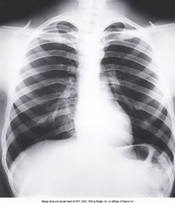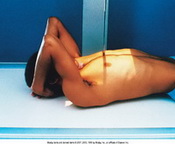IR Size: 14x17 LW
SID: 40""
• A radiopaque spot marker is placed: on skin at area of pain
• Erect preferred to: drop diaphragm & to see air & fluid levels
• Hands on: hips & rotate shoulders forward (Moves scapula out of way)
• _|_ to center of IR
•
•
• Anterior ribs 1-9 with the posterior portions AD
• If ribs 7-9 aren't well demonstrated, angle CR 10-15 caudad
• 1st - 9th ribs in their entirety, with posterior portions above diaphragm
• 1st - 7th anterior ribs from both sides, in their entirety & above diaphragm
• In a unilateral examination, ribs from opposite side possibly not included in entirety.
• Ribs visible through lungs with sufficient contrast




IR Size: 14x17 LW
SID: 40""
• A radiopaque spot marker is placed: on skin at area of pain
• Erect preferred to: drop diaphragm & to see air & fluid levels
• Hands: behind head and point elbows forward to draw scapula laterally
• _|_ to center of IR
•
•
• Posterior ribs 1-10 AD
• For ribs above the diaphragm, 1st - 10th posterior ribs from both sides in their entirety
• Ribs visible through the lungs or abdomen
• In a unilateral examination, ribs from opposite side possibly not included in entirety.




IR Size: 14x17 CW
SID: 40""
• A radiopaque spot marker is placed: on skin at area of pain
• Supine preferred: to raise diaphragm
• Hands: in a comfortable position
• _|_ to center of IR
•
•
• Posterior ribs 8-12 BD
• For ribs below the diaphragm, 8th - 12th posterior ribs on both sides in their entirety
• Ribs visible through the lungs or abdomen
• In a unilateral examination, ribs from opposite side possibly not included in entirety.




IR Size: 14x17 LW
SID: 40""
• A radiopaque spot marker is placed: on skin at area of pain
• Body rotated: 45° affected toward IR
• Abduct arm of: affected (Hand behind head)
• _|_ to center over affected to IR
•
• Collimate
• Suspend on inspiration (AD) Expiration (BD)
• Axillary portion & posterior ribs closest to IR
• Approximately twice as much distance between the vertebral column and the lateral border of the ribs on the affected side as is present on the unaffected side
• Axillary portion of the ribs free of SI
• 1st - 10th ribs visible above diaphragm for upper ribs
• 8th - 12th ribs visible below diaphragm for lower ribs
• Ribs visible through the lungs or abdomen according to region examined




IR Size: 14x17 LW
SID: 40""
• A radiopaque spot marker is placed: on skin at area of pain
• Body rotated: 45° affected away from IR
• Abduct arm of: affected (Hand on Bucky)
• _|_ to center over affected to IR
•
• Collimate
• Suspend on inspiration (AD) Expiration (BD)
• Axillary portion & anterior ribs farthest from IR
• Approximately twice as much distance between the vertebral column and the lateral border of the ribs on the affected side as is present on the unaffected side
• Axillary portion of the ribs free of SI
• 1st - 10th ribs visible above diaphragm for upper ribs
• 8th - 12th ribs visible below diaphragm for lower ribs
• Ribs visible through the lungs or abdomen according to region examined



